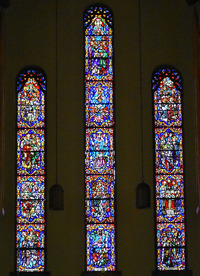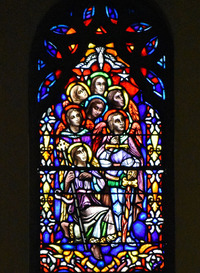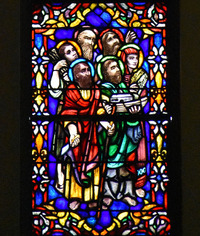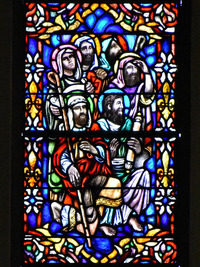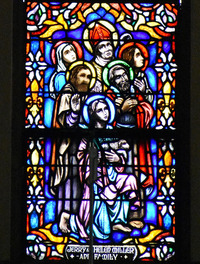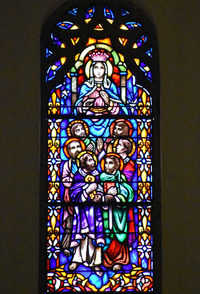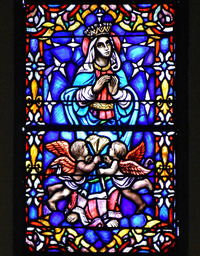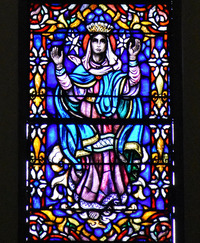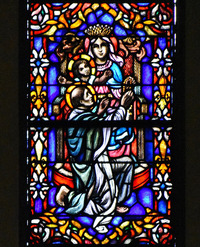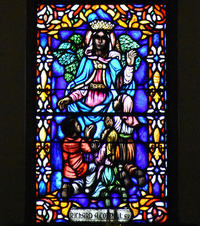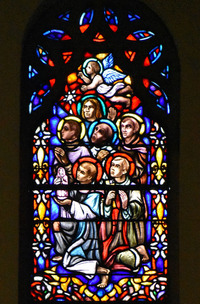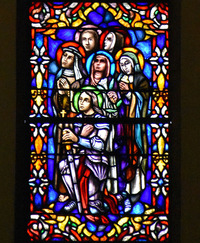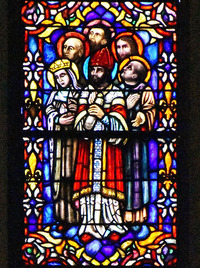Window
Building Name: Our Lady Queen of Apostles Catholic ChurchStudio Name: Willet Hauser Architectural Glass
City: Hamtramck
Window Shape: 6 (gothic arched, more than 2 vertical sections)
Date of Window: 1951
Subject/Title of Window: Our Lady the Queen/Litany of Loreto
Brief Description of Subject: This three lancet window is located in the facade. The scenes illustrate invocations to the Blessed Virgin Mary as found in the Litany of Loreto. This Litany was approved in 1587 by Sixtus V. Since then, Popes have made additions. The Litany consists of mainy invocations covering many topics. This window covers all 12 of the invocations that existed when this Church was built, covering Mary as Queen.
Starting at the top of each lancet, the scenes are basically in the same order as in the Litany. The main differences are: Queen of Martyrs and Queen of Apostles are reversed so that the Queen of Apostles is situated in a more advantageous position on the window and those invocations of the glory of Mary, instead of at the end of the Litany, are placed in the center lancet. Also, Queen of Peace is illuminated with a symbol, not a scene, at the top of the left lancet.
Only the figures with attributes are identified.
Left Lancet:
Queen of Peace, Pray for us. At the top is a dove. In iconography a dove is a symbol for the Holy Spirit or peace. This dove does not have a cruciform halo which is reserved for members of the Trinity so here it is a symbol of peace. Queen of Peace was added to the Litany by Benedict XV in 1916, during WW1.
Scene 1: Queen of Angels, Pray for us. Michael, clad in armor, and Gabriel holding a staff with a cross on top.
Scene 2: Queen of Patriarchs, Pray for us. Abraham with a knife, Isaac (behind Abraham) with firewood, Noah with ark, and Joseph (son of Jacob) with wheat stalks.
Scene 3: Queen of Prophets, Pray for us. Moses with shepherd's staff, kneeling is a figure holding a scroll, the symbol for a prophet.
Scene 4: Queen of Martyrs, Pray for us. St. Agnes with lamb, and possibly St. Stanislaus of Szczepanow, Bishop of Krakow.
The donors' names are Inscribed at the bottom of the window as "Jerry and Hellen Miller and Family."
Center Lancet:
At the top of the center lancet is the Blessed Virgin Mary seated on her throne, and wearing a crown. In view of the Polish heritage of most of the original parishioners when this Church was built, an honorific title for this might be "Our Lady, Queen of Poland."
Scene 1: Queen of Apostles, Pray for us. St. Peter with keys, St. Paul with sword and book, and St. John beardless.
Scene 2: Queen Conceived Without Sin, Pray for us. On December 8, 1661 Pope Alexander issued a Papal Bull allowing one to entertain the idea that Mary was conceived without original sin. Since that time artists have pictured Mary as the woman in Revelation 12:1. This is similar to the way she is pictured in her Assumption into heaven. "Queen Conceived Without Sin" was added to the Litany by Leo XIII in 1883.
Scene 3: Queen Assumed Into Heaven, Pray for us. This invocation was added to the Litany by Pius XII in 1950.
Scene 4: Queen of the Most Holy Rosary, Pray for us. Pictured is the 1208 apparition of St. Dominic Guzman receiving the rosary from the Virgin Mary. This invocation was added to the Litany for the Dominican Order in 1614, for the Confraternity of the Holy Rosary in 1675, and finally for the entire Church in 1883 by Leo XIII.
Scene 5: Not an invocation found in the Litany of Loreto. It pictures the Blessed Virgin Mary with the children. This is a popular subject used on Holy Cards for children.
This Church identified this scene as "Polish Children of Mary." This was quite possibly the intention of the artist as the Church's congregation at this time was chiefly made up of first and second generation immigrants from what is now Poland.
The donor's name is inscribed at the bottom of this window as "Richard A. Connell Sr."
Right Lancet:
At the top of this lancet is a decorative putto.
Scene 1: Queen of Confessors, Pray for us. Confessors means those that have publicly professed their Faith. Believe those being pictured are all Polish saints. St. Hyacinth with statue of Mary, St. Casimir Prince of Poland, with cross, possibly St. Stanislaus Kostka praying.
Scene 2: Queen of Virgins, Pray for us. St. Joan of Arc dressed in armor, St. Theresa of Lisieux holding a cross.
Scene 3 and Scene 4: Queen of All Saints, Pray for us. In scene 3, St. Hedwig, Queen of Poland, holds a church. In Scene 4, King Alphonsus of Leon and Galicia kneeling with a rosary, St. Pope Pius X in white giving a papal blessing, St. Bridget of Kildare in green clothing with shamrock decorations.
The inscription at the bottom indicates this lancet was donated in memory of benefactors.
Inscriptions: Jerry and Helen Miller and Family
Richard A. Connell Sr.
In Memory of Benefactors
Height: 19'
Width: 11'
Our Lady the Queen/Litany of Loreto
Queen of Peace and Queen of Angels
Queen of Patriarchs
Queen of Prophets
Queen of Martyrs
Queen of Apostles
Queen Conceived Without Sin
Queen Assumed Into Heaven
Queen of the Most Holy Rosary
Queen of Polish Children
Queen of Confessors Polish Saints
Queen of Virgins
Queen of All Saints; including St. Hedwig, Queen of Poland
Queen of All Saints; including King Alphonsus, Pope Pius X, and St. Bridget of Kildare
The MSGC is a constantly evolving database. Not all the data that has been collected by volunteers has been sorted and entered. Not every building has been completely documented.
All images in the Index are either born-digital photographs of windows or buildings or are scans of slides, prints, or other published sources. These images have been provided by volunteers and the quality of the material varies widely.
If you have any questions, additions or corrections, or think you can provide better images and are willing to share them, please contact donald20@msu.edu

